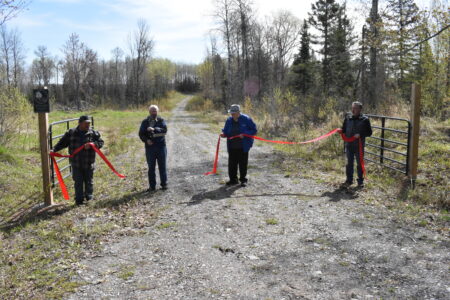Sea lamprey control on Traverse River

By GRAHAM JAEHNIG gjaehnig@mininggazette.com The U.S. Fish and Wildlife Service will conduct an assessment of the Traverse River in Houghton and Keweenaw counties from June 6 to the 14, according to a May 25 statement from the Midwest Region Marquette Biological Station of the Wildlife Service. The purpose is to estimate the abundance of sea lampreys. The information gathered will be used to determine the need for sea lamprey control. Surveying streams that are tributaries of the Great Lakes is the first step in determining the presence of lamprey larvae, the release states. Bob Frank, head of the Marquette Biological Station, covers the larval assessment portion of the program to control seal lamprey levels in the Midwest Region. “Basically, what we do is identify where streams are infested with sea lamprey, how far up the distribution goes, and we have various methods for sampling those lamprey,” He said. Regarding streams to wade in, crews conduct what Frank referred to as a lentic survey, using a lampricide called granular Bayluscide. “We typically will use the Bayluscide on the mouths of positive tributaries, right off shore,” said Frank, “to see if populations are starting to develop out in the lake.” The crew first make sure there isn’t a lot of vegetation or congregated fish, said Frank. They then take some water measurements to determine dissolved oxygen content, temperatures, Ph levels and other measurements. If everything falls within parameters, the crew then applies the lampricide, using a backpack blower. “We apply 20 pounds of the granular Baylascide per each plot. A plot is 518 square meters (5,576 square feet),” said Frank. “then we patrol the area for one hour, scoop up any lamprey that are teased from their burrows looking for oxygen, then we identify the lamprey.” Identification is important, because there are four types of lamprey native to the Great Lakes ecosystem, Frank said. According to the Great Lakes Fishery Commission (GLFC), those four native species are important, because they serve as “ecosystem engineers” by creating diverse flow patterns through spawning nest construction, which improves stream habitat for many aquatic insects and fishes, provide prey for other fish species, and, when migrating through rivers and streams, carry nutrients derived from larger rivers and lakes to upstream habitats. Lamprey native to the Great Lakes do not grow to the size that sea lamprey do, Frank said, and only one of those four are parasitic to fish. Sea Lamprey are not native to the Great Lakes, said Frank, but to the Atlantic Ocean. They entered the ecosystem when the Welland Canal was constructed around Niagara Falls in 1829. “That provided a nexus for them to get in,” said Frank, “and within 20 years they were in every Great Lake,” adding that by the 1950s, the sea lamprey had all but decimated the commercial fisheries During its life as a parasite, one sea lamprey can kill 40 or more pounds of fish. They are so destructive that under some conditions, only one out of seven fish attacked by a sea lamprey will survive. Lamprey impact all species of large Great Lakes fish such as lake trout, salmon, rainbow trout (steelhead), whitefish, chubs, burbot, walleye and catfish, according to the GLFC. “They’re very prolific,” Frank said. “They’re just like a salmon in that they’ll come up in streams in the spring and spawn and that’s the end of the lifecycle for the adults.” The eggs are typically deposited in rock, horseshoe-shaped nests, then hatch within a matter of a few days, he said. They float downstream to the nearest sediment where they burrow and become filter feeders for the next three to five years. “They’re harmless during that infancy stage,” Frank said. “They’re just sitting there, filtering microorganisms and bacteria and things in the water column. But when they get to be about 5 inches, or 120 mm, that indicates to us that we have about a year before they start swimming out into the Great Lakes and attaching to fish.” They will spend the next 12-20 months feeding on fish, states the GLFC. The sea lamprey‘s life cycle, from egg to adult, averages about 6 years, and may last as long as 20 years. Of the 5,747 streams and tributaries of the Great Lakes, 433 are known to produce sea lampreys and about 250 are treated on a regular cycle says the GLFC.
The U.S. Fish and Wildlife Service will conduct an assessment of the Traverse River in Houghton and Keweenaw counties from June 6 to the 14, according to a May 25 statement from the Midwest Region Marquette Biological Station of the Wildlife Service. The purpose is to estimate the abundance of sea lampreys. The information gathered will be used to determine the need for sea lamprey control.
Surveying streams that are tributaries of the Great Lakes is the first step in determining the presence of lamprey larvae, the release states.
Bob Frank, head of the Marquette Biological Station, covers the larval assessment portion of the program to control seal lamprey levels in the Midwest Region.
“Basically, what we do is identify where streams are infested with sea lamprey, how far up the distribution goes, and we have various methods for sampling those lamprey,” He said.
Regarding streams to wade in, crews conduct what Frank referred to as a lentic survey, using a lampricide called granular Bayluscide.
“We typically will use the Bayluscide on the mouths of positive tributaries, right off shore,” said Frank, “to see if populations are starting to develop out in the lake.”
The crew first make sure there isn’t a lot of vegetation or congregated fish, said Frank. They then take some water measurements to determine dissolved oxygen content, temperatures, Ph levels and other measurements. If everything falls within parameters, the crew then applies the lampricide, using a backpack blower.
“We apply 20 pounds of the granular Baylascide per each plot. A plot is 518 square meters (5,576 square feet),” said Frank. “then we patrol the area for one hour, scoop up any lamprey that are teased from their burrows looking for oxygen, then we identify the lamprey.”
Identification is important, because there are four types of lamprey native to the Great Lakes ecosystem, Frank said.
According to the Great Lakes Fishery Commission (GLFC), those four native species are important, because they serve as “ecosystem engineers” by creating diverse flow patterns through spawning nest construction, which improves stream habitat for many aquatic insects and fishes, provide prey for other fish species, and, when migrating through rivers and streams, carry nutrients derived from larger rivers and lakes to upstream habitats.
Lamprey native to the Great Lakes do not grow to the size that sea lamprey do, Frank said, and only one of those four are parasitic to fish.
Sea Lamprey are not native to the Great Lakes, said Frank, but to the Atlantic Ocean. They entered the ecosystem when the Welland Canal was constructed around Niagara Falls in 1829.
“That provided a nexus for them to get in,” said Frank, “and within 20 years they were in every Great Lake,” adding that by the 1950s, the sea lamprey had all but decimated the commercial fisheries
During its life as a parasite, one sea lamprey can kill 40 or more pounds of fish. They are so destructive that under some conditions, only one out of seven fish attacked by a sea lamprey will survive.
Lamprey impact all species of large Great Lakes fish such as lake trout, salmon, rainbow trout (steelhead), whitefish, chubs, burbot, walleye and catfish, according to the GLFC.
“They’re very prolific,” Frank said. “They’re just like a salmon in that they’ll come up in streams in the spring and spawn and that’s the end of the lifecycle for the adults.”
The eggs are typically deposited in rock, horseshoe-shaped nests, then hatch within a matter of a few days, he said. They float downstream to the nearest sediment where they burrow and become filter feeders for the next three to five years.
“They’re harmless during that infancy stage,” Frank said. “They’re just sitting there, filtering microorganisms and bacteria and things in the water column. But when they get to be about 5 inches, or 120 mm, that indicates to us that we have about a year before they start swimming out into the Great Lakes and attaching to fish.”
They will spend the next 12-20 months feeding on fish, states the GLFC. The sea lamprey’s life cycle, from egg to adult, averages about 6 years, and may last as long as 20 years.
Of the 5,747 streams and tributaries of the Great Lakes, 433 are known to produce sea lampreys and about 250 are treated on a regular cycle says the GLFC.




